人血小板活化因子(PAF)分析检测ELISA试剂盒使用说明书
ELISA试剂盒说明书,人骨髓抑制因子1elisa试剂盒

ELISA试剂盒说明书,人骨髓抑制因子1elisa试剂盒ELISA试剂盒说明书,人骨髓抑制因子1elisa试剂盒供应商:上海樊克生物有限公司ELISA试剂盒规格:(1) 规格:96T 可以测90个样,5个标准孔,1个空白孔(2)规格:48T 可以测42个样,5个标准孔,1个空白孔保存条件:2-8℃低温保存保质期:6个月,所有试剂盒均提供最新批次。
试剂盒成分:酶标板,试剂,标准品等。
ELISA试剂盒说明书,人骨髓抑制因子1elisa试剂盒试剂准备试剂盒从冷藏环境中取出应在室温平衡后方可使用。
1. 标准品复溶:试剂盒提供6管标准品,每管已标定浓度,并且冻干。
实验前在每个标准品管中加入0.5mL样本稀释液,盖好后静置10分钟以上,然后反复颠倒/搓动助其溶解,使其恢复为每个标准品管身标注的浓度。
2. 20×洗涤缓冲液的稀释:蒸馏水按1:20稀释,即1份20×洗涤缓冲液加19份蒸馏水。
试剂盒性能:1.样品线性回归与预期浓度相关系数R值为0.990以上。
2.批内与批见应分别小于9%和11%ELISA试剂盒说明书,人骨髓抑制因子1elisa试剂盒试剂的准备:按试剂盒说明书的要求准备实验中需用的试剂。
ELISA中用的蒸馏水或去离子水,包括用于洗涤的,应为新鲜的和高质量的。
自配的缓冲液应用pH计测量较正。
从冰箱中取出的试验用试剂应待温度与室温平衡后使用。
试剂盒中本次试验不需用的部分应及时放回冰箱保存。
ELISA试剂盒的优势:全面——混合 8 种不同的常见抗原,对自身免疫性疾病进行全面筛查。
快速——检测时间短( ~2 小时),确诊时间更早准确——ELISA 检测方法,灵敏度高,特异性强,适用性好。
质优——美国技术开发,高品质及高可靠性的分析性能。
价低——国内自生产,符合国内实情,降低生产成本。
ELISA试剂盒说明书,人骨髓抑制因子1elisa试剂盒Matters needing attention:1 kit from the cold storage environment should be taken in the room temperature balance 15-30 minutes after the use of the enzyme labeled package was not used after the plate Kaifeng, the board should be loaded into the sealed bag.2 washing buffer will crystallization, heated the water solubilization dilution, washing does not affect the results.3 each step sample should be used, and often to check its accuracy, in order to avoid the test error. A sample within 5 mins, ifthenumberofsampleismuch, recommend to use volley like.4 please each simultaneous determination of standard curve, it is best to do multiple holes. Such as samples to be measured matter content is too high (the sample od high standard product the first hole hole OD), please first sample dilution multiples (n times) were measured and calculated please then multiplied by the total dilution ratio (n * * 5).5 closure plate membrane only a one-time use, to avoid cross contamination.The 6 substrate stored.7 in strict accordance with the instructions of the operation, determine the test results to the microtiter plate reader as a standard.8 of all samples, washing liquid and various waste materials are handled should be transmitted.9 different batches of this reagent can not be mixed.10 and English instructions are different, the English specification shall prevai ELISA试剂盒说明书,人骨髓抑制因子1elisa试剂盒ELISA试剂盒说明书,人骨髓抑制因子1elisa试剂盒具有以下优点:1)快速:仅需传统夹心法ELISA 1/3的操作时间,1小时即可完成整个试验流程;2)简单:只需1个洗涤步骤;3)灵活:可单独或同时检测总蛋白及磷酸化蛋白,可在同一板上检测不同的靶蛋白;4)灵敏:达到甚至超过行业标准,且结果一致性良好;5)兼容:常规比色法检测,实验室常规酶标仪读数;ELISA试剂盒说明书,人骨髓抑制因子1elisa试剂盒产品特点:1.专一性强,灵敏度高2.免费提供产品最新报价,实验原理,产品用途及中英文说明书。
Elabscience 人血小板生成素(TPO)酶联免疫吸附测定试剂盒使用说明书
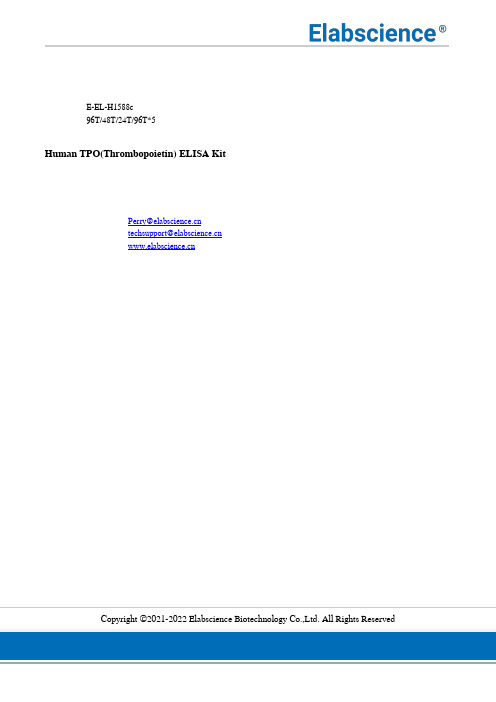
2022年修订第一版(本试剂盒仅供体外研究使用,不用于临床诊断!)产品货号:E-EL-H1588c产品规格:96T/48T/24T/96T*5Elabscience 人血小板生成素(TPO)酶联免疫吸附测定试剂盒使用说明书Human TPO(Thrombopoietin) ELISA Kit使用前请仔细阅读说明书。
如果有任何问题,请通过以下方式联系我们:销售部电话技术部电话************电子邮箱(销售)********************电子邮箱(技术)**************************网址:具体保质期请见试剂盒外包装标签。
请在保质期内使用试剂盒。
联系时请提供产品批号(见试剂盒标签),以便我们更高效地为您服务。
Copyright ©2021-2022 Elabscience Biotechnology Co.,Ltd. All Rights Reserved目录用途 (3)基本性能 (3)检测原理 (3)试剂盒组成及保存 (4)试验所需自备物品 (5)样品收集方法 (5)注意事项 (6)■ 试剂盒注意事项 (6)■ 样品注意事项 (6)样本稀释方案 (6)检测前准备工作 (7)操作步骤 (8)结果判断 (10)技术资源 (10)典型数据 (10)性能 (11)■ 精密度 (11)■ 回收率 (11)■ 线性 (11)声明 (12)Intended use (13)Character (13)Test principle (13)Kit components & Storage (14)Other supplies required (15)Sample collection (15)Note (16)■ Note for kit (16)■ Note for sample (16)Dilution Method (17)Reagent preparation (17)Assay procedure (18)Calculation of results (20)Technical resources (20)Typical data (20)Performance (21)■ Precision (21)■ Recovery (21)■ Linearity (21)Declaration (22)用途该试剂盒用于体外定量检测人 血清、血浆或其他相关生物液体中TPO浓度。
人凝血酶调节蛋白 ELISA 试剂盒说明书

REV20190712仅供研究,不用于临床诊断。
客服热线: 400-7060-959﹡技术支持邮箱: **************公司官网: 目录简介 ......................................................................................................................................................................... - 3 -检测原理 ................................................................................................................................................................. - 3 -试剂盒组分 ............................................................................................................................................................. - 4 -储存条件 ................................................................................................................................................................. - 5 -其他实验材料 ......................................................................................................................................................... - 5 -注意事项 ................................................................................................................................................................. - 5 -样本收集处理及保存方法 ..................................................................................................................................... - 6 -试剂准备 ................................................................................................................................................................. - 6 -操作步骤 ................................................................................................................................................................. - 8 -操作流程图 ............................................................................................................................................................. - 8 -操作要点提示 ......................................................................................................................................................... - 9 -结果判断 ................................................................................................................................................................. - 9 -结果重复性 ........................................................................................................................................................... - 10 -灵敏度 ................................................................................................................................................................... - 10 -特异性 ................................................................................................................................................................... - 10 -参考文献 ............................................................................................................................................................... - 10 -该产品由北京四正柏生物科技有限公司研制。
人血管内皮生长因子 ELISA 试剂盒说明书
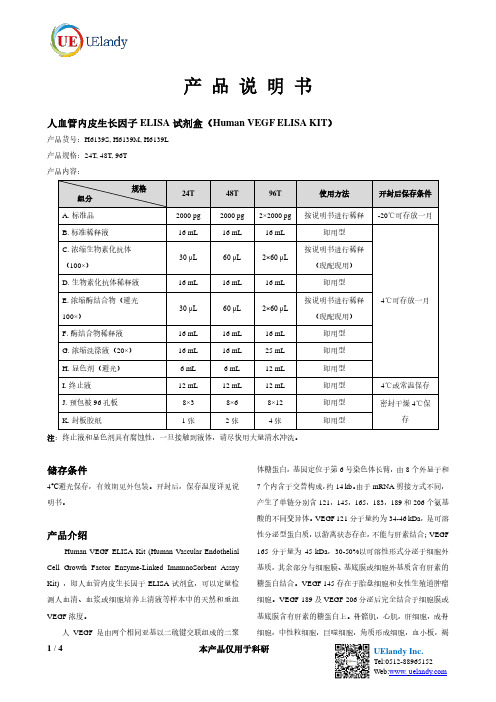
产品说明书人血管内皮生长因子ELISA试剂盒(Human VEGF ELISA KIT)产品货号:H6139S, H6139M, H6139L产品规格:24T, 48T, 96T产品内容:注:终止液和显色剂具有腐蚀性,一旦接触到液体,请尽快用大量清水冲洗。
储存条件4℃避光保存,有效期见外包装。
开封后,保存温度详见说明书。
产品介绍Human VEGF ELISA Kit (Human Vascular Endothelial Cell Growth Factor Enzyme-Linked ImmunoSorbent Assay Kit) ,即人血管内皮生长因子ELISA试剂盒,可以定量检测人血清、血浆或细胞培养上清液等样本中的天然和重组VEGF浓度。
人VEGF是由两个相同亚基以二硫键交联组成的二聚体糖蛋白,基因定位于第6号染色体长臂,由8个外显子和7个内含子交替构成,约14 kb。
由于mRNA剪接方式不同,产生了单链分别含121,145,165,183,189和206个氨基酸的不同变异体。
VEGF 121分子量约为34-46 kDa,是可溶性分泌型蛋白质,以游离状态存在,不能与肝素结合;VEGF 165分子量为45 kDa,30-50%以可溶性形式分泌于细胞外基质,其余部分与细胞膜、基底膜或细胞外基质含有肝素的糖蛋白结合。
VEGF 145存在于胎盘细胞和女性生殖道肿瘤细胞。
VEGF 189及VEGF 206分泌后完全结合于细胞膜或基底膜含有肝素的糖蛋白上。
骨骼肌,心肌,肝细胞,成骨细胞,中性粒细胞,巨噬细胞,角质形成细胞,血小板,褐色脂肪组织,CD34+细胞,星形细胞,神经元和内皮细胞等多种细胞和组织均可产生VEGF。
血清和血浆样本均可检测到VEGF,由于血小板可释放VEGF,因此血清中VEGF含量较高。
VEGF是一种特异作用于血管内皮细胞的多功能细胞因子,可增加血管通透性、促进血管形成、引起细胞外基质成分改变等。
人血小板生长因子(PGF)酶联免疫(ELISA)分析试剂盒使用说明书
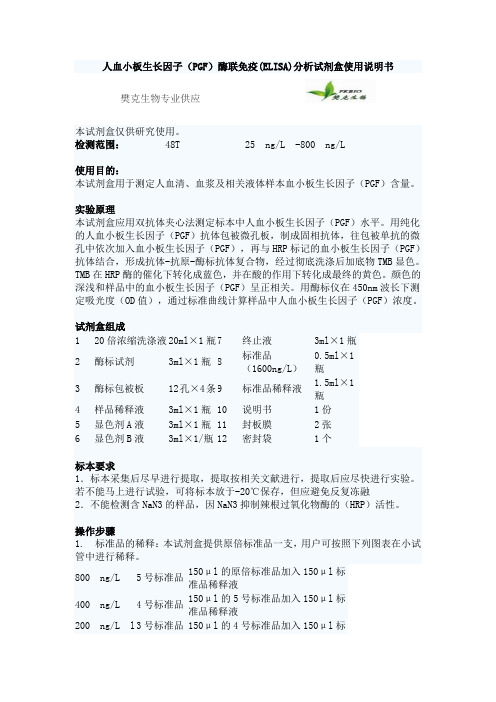
人血小板生长因子(PGF)酶联免疫(ELISA)分析试剂盒使用说明书樊克生物专业供应本试剂盒仅供研究使用。
检测范围:48T 25 ng/L -800 ng/L使用目的:本试剂盒用于测定人血清、血浆及相关液体样本血小板生长因子(PGF)含量。
实验原理本试剂盒应用双抗体夹心法测定标本中人血小板生长因子(PGF)水平。
用纯化的人血小板生长因子(PGF)抗体包被微孔板,制成固相抗体,往包被单抗的微孔中依次加入血小板生长因子(PGF),再与HRP标记的血小板生长因子(PGF)抗体结合,形成抗体-抗原-酶标抗体复合物,经过彻底洗涤后加底物TMB显色。
TMB在HRP酶的催化下转化成蓝色,并在酸的作用下转化成最终的黄色。
颜色的深浅和样品中的血小板生长因子(PGF)呈正相关。
用酶标仪在450nm波长下测定吸光度(OD值),通过标准曲线计算样品中人血小板生长因子(PGF)浓度。
试剂盒组成1 20倍浓缩洗涤液20ml×1瓶7 终止液3ml×1瓶2 酶标试剂3ml×1瓶 8 标准品(1600ng/L)0.5ml×1瓶3 酶标包被板12孔×4条9 标准品稀释液1.5ml×1瓶4 样品稀释液3ml×1瓶 10 说明书1份5 显色剂A液3ml×1瓶 11 封板膜2张6 显色剂B液3ml×1/瓶12 密封袋1个标本要求1.标本采集后尽早进行提取,提取按相关文献进行,提取后应尽快进行实验。
若不能马上进行试验,可将标本放于-20℃保存,但应避免反复冻融2.不能检测含NaN3的样品,因NaN3抑制辣根过氧化物酶的(HRP)活性。
操作步骤1. 标准品的稀释:本试剂盒提供原倍标准品一支,用户可按照下列图表在小试管中进行稀释。
800 ng/L 5号标准品150μl的原倍标准品加入150μl标准品稀释液400 ng/L 4号标准品150μl的5号标准品加入150μl标准品稀释液200 ng/L l 3号标准品 150μl的4号标准品加入150μl标准品稀释液100 ng/L 2号标准品150μl的3号标准品加入150μl标准品稀释液50 ng/L 1号标准品150μl的2号标准品加入150μl标准品稀释液2. 加样:分别设空白孔(空白对照孔不加样品及酶标试剂,其余各步操作相同)、标准孔、待测样品孔。
血小板抗体检测试剂盒(固相凝集法)使用操作说明

血小板抗体检测试剂盒(固相凝集法)使用操作方法1、平衡室温取出血小板抗体检测试剂盒(固相凝集法)、血小板抗体检测用指示红细胞(固相凝集法)、血小板抗体筛检细胞(冻干粉)放在室温中平衡至室温。
2、检测样本准备将血浆(血清)3000转离心5-10分钟。
3、配制浓缩洗涤液将浓缩洗涤液以1:24比例与蒸馏水混合(满瓶20ML浓缩洗涤液兑480ML蒸馏水)。
4、配制血小板抗体筛检细胞(冻干粉)将冻干粉依比例与生理盐水混合(冻干粉0.5ML与0.5ML生理盐水混合),混合后放置5分钟,使用前轻轻摇匀。
5、标识由包装内取出一条反应板,平衡至室温。
标记阳性对照、阴性对照、检测样本序号。
6、加血小板向反应板孔中各加入1滴(约50µl)混匀的血小板悬液,轻摇反应板约10秒钟。
7、固着将反应板用平板离心机以50g离心5分钟(专用血小板离心机用程序1)。
8、洗涤将反应板用洗涤液洗3至4次,洗涤过程中轻摇微孔板,然后再轻轻甩掉洗涤液。
最后一次洗涤后将残余液体蘸干。
9、加样先向各孔中加入2滴(100µl)低离子强度溶液,再分别滴加1滴(50µl)阳性对照、阴性对照、检测样本。
10、孵育将反应孔用封口胶纸封好,轻摇混匀后置湿盒中37℃孵育30分钟(或气浴孵育35至40分钟)。
11、洗涤(同步骤8)反复洗涤5至6次。
12、加指示物立即向上述各孔加入1滴抗人IgG(50µl)和1滴(50µl)混匀的血小板抗体检测用指示红细胞悬液,轻轻振荡混匀。
13、离心将反应板以200g离心5分钟(专用血小板离心机用程序2)。
14、结果判定观察并记录实验结果。
阳性反应为指示红细胞黏附在反应孔底部表面,而阴性反应为指示红细胞在离心力的作用下聚集于反应孔底部中央,弱阳性反应格局介于两者之间。
血小板活化因子的作用

血小板活化因子的作用引言血小板活化因子(Platelet-activating factor,PAF)是一种具有多种生物活性的脂类分子,在多个生理和病理过程中发挥重要作用。
本文将详细介绍血小板活化因子的结构、合成、作用机制以及其在炎症、免疫应答、血栓形成等过程中的作用。
结构特点血小板活化因子是一种磷脂类物质,具有以下结构特点:- 磷脂酰胆碱(phosphatidylcholine,PC)头基 - 烷基链 - 右边酯键上的桥联脂基 - 链上的一个酯键和草酰基合成和释放血小板活化因子的合成和释放主要发生在炎症和免疫细胞中,包括巨噬细胞、嗜酸性粒细胞和血小板。
它可以通过以下几个途径合成和释放:1.磷脂酰胆碱合成途径:血小板活化因子可以通过磷脂酰胆碱合成途径合成。
具体来说,磷脂酰胆碱通过氧化酶催化生成活性氧,然后与磷脂成环形成血小板活化因子。
2.磷脂酰胆碱的酶解途径:磷脂酰胆碱可以通过脂酶D的作用被水解为磷脂酰乙醇胺(phosphatidylethanolamine),然后被氧化酶催化生成血小板活化因子。
3.膜磷脂的降解途径:细胞膜中的磷脂可以通过磷脂酶C的作用被水解为酪胺酸和二酸甘油醇磷酸脂,然后被磷脂酰转移酶催化生成血小板活化因子。
作用机制血小板活化因子通过与其受体结合,触发下游的信号传导通路,从而产生多种生物学效应。
1.血小板激活:血小板活化因子可以通过与血小板表面的受体结合,引起血小板粘附、聚集和释放胞内储存的生物活性物质,如血小板因子4(plateletfactor 4,PF4)和血小板生长因子(platelet-derived growth factor,PDGF),从而促进血小板激活和血栓形成。
2.炎症反应:血小板活化因子可以调节炎症反应,并参与炎症介质的合成和释放。
它可以促进炎症细胞的粘附和迁移,增加血管通透性,引发炎症反应。
3.免疫调节:血小板活化因子对免疫细胞的功能具有调节作用。
它可以改变巨噬细胞和淋巴细胞的活性,影响细胞因子的合成和释放,调节免疫应答。
血小板活化因子的名词解释

血小板活化因子的名词解释血小板活化因子(Platelet Activating Factors,PAFs)是一类重要的生物分子,属于炎症介质之一,对维持血管壁完整性,参与炎症和免疫等生物学过程起着重要调节作用。
本文将对血小板活化因子的概念、发现历程及其功能进行详细解释。
一、什么是血小板活化因子?血小板活化因子最早是由巴黎大学的研究者们于上世纪60年代初期发现的一种具有强烈生物活性的分子。
血小板活化因子是一类磷脂体的衍生物,其中最具代表性的是磷脂酰胆碱(platelet-activating factor,PAF)。
PAF是一种低分子量的生物活性磷脂酰胆碱类物质,具有非常强的生物活性和广泛的生物学效应。
二、血小板活化因子的发现历程血小板活化因子最早是研究者通过识别和分离红细胞溶血产物中的活性分子得到的。
随后的研究发现了PAF的存在,同时也发现了PAF受体的存在。
由于其重要的生物学功能,血小板活化因子引起了科学界的广泛关注。
在后续的研究中,科学家不仅发现了PAF分子结构的特点,还揭示了PAF参与的多种生理和病理过程。
三、血小板活化因子的功能血小板活化因子在机体内发挥着广泛而重要的生物学功能,它们能够调节细胞的生理活动以及免疫、炎症反应等过程。
主要功能有以下几个方面:1. 血管活性:PAF能够引起平滑肌的收缩,从而导致血管收缩,增加心脏的负荷,使血管变窄,影响血流的流速和血管通透性,同时也会促进血小板的聚集和粘附。
2. 免疫和炎症反应:血小板活化因子能够启动炎症反应,通过促进炎症细胞的激活和趋化,参与炎症介质的生成和释放,增强炎症反应的强度和持续时间,并参与机体免疫应答。
3. 血小板激活:血小板活化因子被广泛用于刺激和调节血小板的活化,增强血小板的粘附、聚集和释放,促进血栓形成,是血栓形成过程中的重要调节因子。
4. 神经功能:最新的研究表明,血小板活化因子在中枢神经系统中也有一定的作用。
它能够影响神经元的兴奋性,参与神经发育和神经退行性疾病的发生。
人IL-13 ELISA试剂盒产品说明书

REV20190712仅供研究,不用于临床诊断。
客服热线: 400-7060-959﹡技术支持邮箱: **************公司官网: 目录简介 ......................................................................................................................................................................... - 3 -检测原理 ................................................................................................................................................................. - 3 -试剂盒组分 ............................................................................................................................................................. - 4 -储存条件 ................................................................................................................................................................. - 5 -其他实验材料 ......................................................................................................................................................... - 5 -注意事项 ................................................................................................................................................................. - 5 -样本收集处理及保存方法 ..................................................................................................................................... - 6 -试剂准备 ................................................................................................................................................................. - 6 -操作步骤 ................................................................................................................................................................. - 8 -操作流程图 ............................................................................................................................................................. - 8 -操作要点提示 ......................................................................................................................................................... - 9 -结果判断 ................................................................................................................................................................. - 9 -结果重复性 ........................................................................................................................................................... - 10 -灵敏度 ................................................................................................................................................................... - 10 -特异性 ................................................................................................................................................................... - 10 -参考文献 ............................................................................................................................................................... - 10 -该产品由北京四正柏生物科技有限公司研制。
大鼠血小板活化因子(PAF)ELISA试剂盒说明书
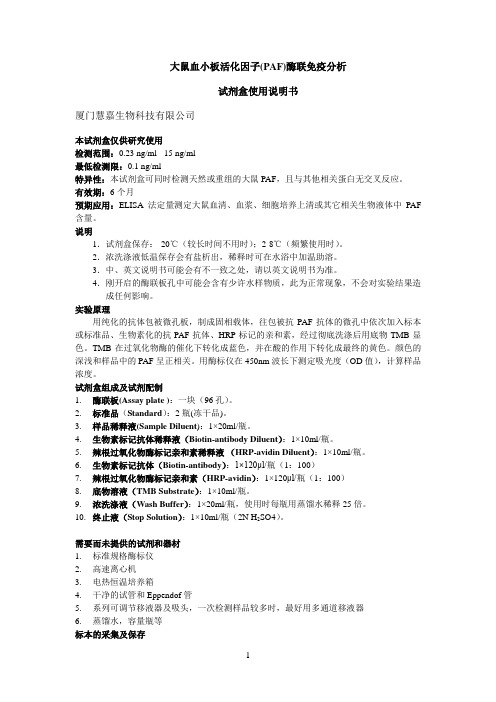
大鼠血小板活化因子(PAF)酶联免疫分析试剂盒使用说明书厦门慧嘉生物科技有限公司本试剂盒仅供研究使用检测范围:0.23 ng/ml - 15 ng/ml最低检测限:0.1 ng/ml特异性:本试剂盒可同时检测天然或重组的大鼠PAF,且与其他相关蛋白无交叉反应。
有效期:6个月预期应用:ELISA法定量测定大鼠血清、血浆、细胞培养上清或其它相关生物液体中PAF 含量。
说明1.试剂盒保存:-20℃(较长时间不用时);2-8℃(频繁使用时)。
2.浓洗涤液低温保存会有盐析出,稀释时可在水浴中加温助溶。
3.中、英文说明书可能会有不一致之处,请以英文说明书为准。
4.刚开启的酶联板孔中可能会含有少许水样物质,此为正常现象,不会对实验结果造成任何影响。
实验原理用纯化的抗体包被微孔板,制成固相载体,往包被抗PAF抗体的微孔中依次加入标本或标准品、生物素化的抗PAF抗体、HRP标记的亲和素,经过彻底洗涤后用底物TMB显色。
TMB在过氧化物酶的催化下转化成蓝色,并在酸的作用下转化成最终的黄色。
颜色的深浅和样品中的PAF呈正相关。
用酶标仪在450nm波长下测定吸光度(OD值),计算样品浓度。
试剂盒组成及试剂配制1.酶联板(Assay plate ):一块(96孔)。
2.标准品(Standard):2瓶(冻干品)。
3.样品稀释液(Sample Diluent):1×20ml/瓶。
4.生物素标记抗体稀释液(Biotin-antibody Diluent):1×10ml/瓶。
5.辣根过氧化物酶标记亲和素稀释液(HRP-avidin Diluent):1×10ml/瓶。
6.生物素标记抗体(Biotin-antibody):1×120μl/瓶(1:100)7.辣根过氧化物酶标记亲和素(HRP-avidin):1×120μl/瓶(1:100)8.底物溶液(TMB Substrate):1×10ml/瓶。
人B因子(BF)ELISA检测试剂盒说明

人B因子(BF)ELISA检测试剂盒说明书本试剂仅供研究使用标本:血清或血浆樊克生物专业供应:使用目的:本试剂盒用于测定人血清、血浆及相关液体样本B因子(BF)含量。
试验原理:BF试剂盒是固相夹心法酶联免疫吸附实验(ELISA).已知BF浓度的标准品、未知浓度的样品加入微孔酶标板内进行检测。
先将BF和生物素标记的抗体同时温育。
洗涤后,加入亲和素标记过的HRP。
再经过温育和洗涤,去除未结合的酶结合物,然后加入底物A、B,和酶结合物同时作用。
产生颜色。
颜色的深浅和样品中BF的浓度呈比例关系。
试剂盒内容及其配制试剂盒成份(2-8℃保存)96孔配置48孔配置配制96/48人份酶标板1块板(96T)半块板(48T)即用型塑料膜板盖1块半块即用型标准品:80ng/ml 1瓶(0.6ml)1瓶(0.3ml)按说明书进行稀稀空白对照1瓶(1.0ml)1瓶(0.5ml)即用型标准品稀释缓冲液1瓶(5ml)1瓶(2.5ml)即用型生物素标记的抗BF抗体1瓶(6ml)1瓶(3.0ml)即用型亲和链酶素-HRP 1瓶(10ml)1瓶(5.0ml)即用型洗涤缓冲液1瓶(20ml)1瓶(10ml)按说明书进行稀释底物A 1瓶(6.0ml)1瓶(3.0ml)即用型底物B 1瓶(6.0ml)1瓶(3.0ml)即用型终止液1瓶(6.0ml)1瓶(3.0ml)即用型标本稀释液1瓶(12ml)1瓶(6.0ml)即用型自备材料1.蒸馏水。
2.加样器:5ul、10ul、50ul、100ul、200ul、500ul、1000ul。
3.振荡器及磁力搅拌器等。
安全性1.避免直接接触终止液和底物A、B。
一旦接触到这些液体,请尽快用水冲洗。
2.实验中不要吃喝、抽烟或使用化妆品。
3.不要用嘴吸取试剂盒里的任何成份。
操作注意事项1.试剂应按标签说明书储存,使用前恢复到室温。
稀稀过后的标准品应丢弃,不可保存。
2.实验中不用的板条应立即放回包装袋中,密封保存,以免变质。
ELISA检测试剂盒使用指南
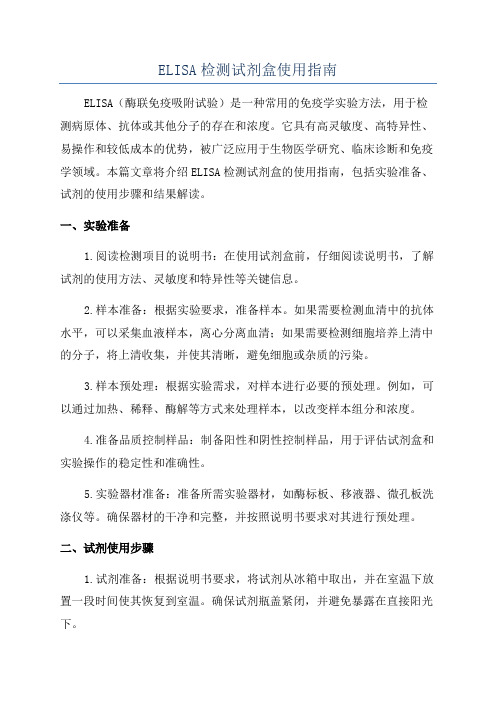
ELISA检测试剂盒使用指南ELISA(酶联免疫吸附试验)是一种常用的免疫学实验方法,用于检测病原体、抗体或其他分子的存在和浓度。
它具有高灵敏度、高特异性、易操作和较低成本的优势,被广泛应用于生物医学研究、临床诊断和免疫学领域。
本篇文章将介绍ELISA检测试剂盒的使用指南,包括实验准备、试剂的使用步骤和结果解读。
一、实验准备1.阅读检测项目的说明书:在使用试剂盒前,仔细阅读说明书,了解试剂的使用方法、灵敏度和特异性等关键信息。
2.样本准备:根据实验要求,准备样本。
如果需要检测血清中的抗体水平,可以采集血液样本,离心分离血清;如果需要检测细胞培养上清中的分子,将上清收集,并使其清晰,避免细胞或杂质的污染。
3.样本预处理:根据实验需求,对样本进行必要的预处理。
例如,可以通过加热、稀释、酶解等方式来处理样本,以改变样本组分和浓度。
4.准备品质控制样品:制备阳性和阴性控制样品,用于评估试剂盒和实验操作的稳定性和准确性。
5.实验器材准备:准备所需实验器材,如酶标板、移液器、微孔板洗涤仪等。
确保器材的干净和完整,并按照说明书要求对其进行预处理。
二、试剂使用步骤1.试剂准备:根据说明书要求,将试剂从冰箱中取出,并在室温下放置一段时间使其恢复到室温。
确保试剂瓶盖紧闭,并避免暴露在直接阳光下。
2.实验操作:按照说明书的要求,将试剂加入到酶标板中,并根据实验设计进行标准曲线的设置。
标准曲线用于测量未知样品的数量,并计算出浓度。
3.孵育:根据试剂盒的要求,将酶标板放入孵育箱中进行孵育。
孵育温度和时间应根据实验要求进行调整。
4.洗涤:使用洗涤缓冲液对酶标板上的不特异性结合物进行洗涤。
洗涤过程应准确控制洗涤孔板次数和洗涤液的体积。
5.补液:在洗涤完成后,加入辣根过氧化物酶标况稀释液,促进酶标物与特异性结合物的反应。
6.孵育:根据试剂盒的要求,将酶标板放入孵育箱中进行二次孵育。
7.反应停止:根据试剂盒的要求,加入相应的停止液,停止酶反应。
ELISA 检测试剂盒 说明书
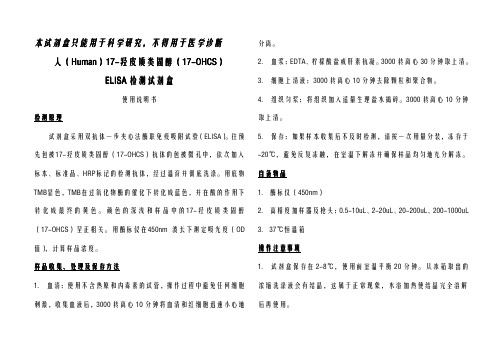
本试剂盒只能用于科学研究,不得用于医学诊断人(Human Human))17-17-羟皮质类固醇(羟皮质类固醇(羟皮质类固醇(17-OHCS 17-OHCS 17-OHCS))ELISA 检测试剂盒使用说明书检测原理试剂盒采用双抗体一步夹心法酶联免疫吸附试验(ELISA)。
往预先包被17-羟皮质类固醇(17-OHCS)抗体的包被微孔中,依次加入标本、标准品、HRP标记的检测抗体,经过温育并彻底洗涤。
用底物TMB显色,TMB在过氧化物酶的催化下转化成蓝色,并在酸的作用下转化成最终的黄色。
颜色的深浅和样品中的17-羟皮质类固醇(17-OHCS)呈正相关。
用酶标仪在450nm 波长下测定吸光度(OD 值),计算样品浓度。
样品收集、处理及保存方法1.血清:使用不含热原和内毒素的试管,操作过程中避免任何细胞刺激,收集血液后,3000转离心10分钟将血清和红细胞迅速小心地分离。
2.血浆:EDTA、柠檬酸盐或肝素抗凝。
3000转离心30分钟取上清。
3.细胞上清液:3000转离心10分钟去除颗粒和聚合物。
4.组织匀浆:将组织加入适量生理盐水捣碎。
3000转离心10分钟取上清。
5.保存:如果样本收集后不及时检测,请按一次用量分装,冻存于-20℃,避免反复冻融,在室温下解冻并确保样品均匀地充分解冻。
自备物品1.酶标仪(450nm)2.高精度加样器及枪头:0.5-10uL、2-20uL、20-200uL、200-1000uL3.37℃恒温箱操作注意事项1.试剂盒保存在2-8℃,使用前室温平衡20分钟。
从冰箱取出的浓缩洗涤液会有结晶,这属于正常现象,水浴加热使结晶完全溶解后再使用。
2.实验中不用的板条应立即放回自封袋中,密封(低温干燥)保存。
3.浓度为0的S0号标准品即可视为阴性对照或者空白;按照说明书操作时样本已经稀释5倍,最终结果乘以5才是样本实际浓度。
4.严格按照说明书中标明的时间、加液量及顺序进行温育操作。
5.所有液体组分使用前充分摇匀。
elisa试剂盒,二胺氧化酶,人ELISA试剂盒说明书
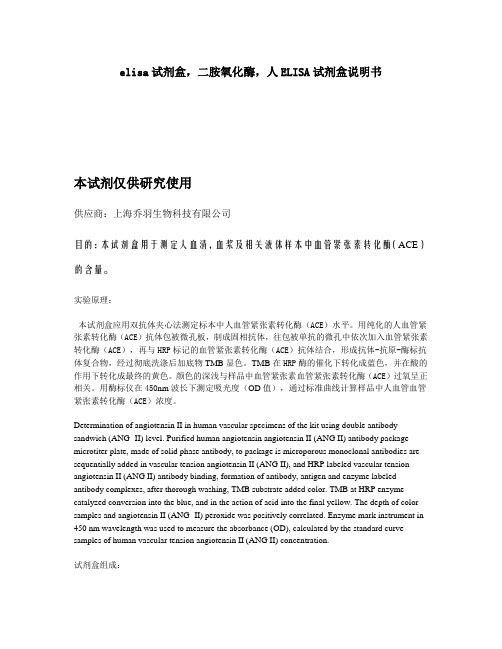
elisa试剂盒,二胺氧化酶,人ELISA试剂盒说明书本试剂仅供研究使用供应商:上海乔羽生物科技有限公司目的:本试剂盒用于测定人血清,血浆及相关液体样本中血管紧张素转化酶(ACE)的含量。
实验原理:本试剂盒应用双抗体夹心法测定标本中人血管紧张素转化酶(ACE)水平。
用纯化的人血管紧张素转化酶(ACE)抗体包被微孔板,制成固相抗体,往包被单抗的微孔中依次加入血管紧张素转化酶(ACE),再与HRP标记的血管紧张素转化酶(ACE)抗体结合,形成抗体-抗原-酶标抗体复合物,经过彻底洗涤后加底物TMB显色。
TMB在HRP酶的催化下转化成蓝色,并在酸的作用下转化成最终的黄色。
颜色的深浅与样品中血管紧张素血管紧张素转化酶(ACE)过氧呈正相关。
用酶标仪在450nm波长下测定吸光度(OD值),通过标准曲线计算样品中人血管血管紧张素转化酶(ACE)浓度。
Determination of angiotensin II in human vascular specimens of the kit using double antibody sandwich (ANG- II) level. Purified human angiotensin angiotensin II (ANG II) antibody package microtiter plate, made of solid phase antibody, to package is microporous monoclonal antibodies are sequentially added in vascular tension angiotensin II (ANG II), and HRP labeled vascular tension angiotensin II (ANG II) antibody binding, formation of antibody, antigen and enzyme labeled antibody complexes, after thorough washing, TMB substrate added color. TMB at HRP enzyme catalyzed conversion into the blue, and in the action of acid into the final yellow. The depth of color samples and angiotensin II (ANG- II) peroxide was positively correlated. Enzyme mark instrument in 450 nm wavelength was used to measure the absorbance (OD), calculated by the standard curve samples of human vascular tension angiotensin II (ANG II) concentration.试剂盒组成:试剂盒组成48孔配置96孔配置保存说明书1份1份封板膜2片(48)2片(96)密封袋1个1个酶标包被板1×481×962-8℃保存标准品:27ng/mL0.5ml×1瓶0.5ml×1瓶2-8℃保存标准品稀释液 1.5ml×1瓶 1.5ml×1瓶2-8℃保存酶标试剂 3 ml×1瓶 6 ml×1瓶2-8℃保存样品稀释液 3 ml×1瓶 6 ml×1瓶2-8℃保存显色剂A液 3 ml×1瓶 6 ml×1瓶2-8℃保存显色剂B液 3 ml×1瓶 6 ml×1瓶2-8℃保存终止液3ml×1瓶6ml×1瓶2-8℃保存浓缩洗涤液(20ml×20倍)×1瓶(20ml×30倍)×1瓶2-8℃保存样本处理及要求:1. 血清:室温血液自然凝固10-20分钟,离心20分钟左右(2000-3000转/分)。
PAPP-A ELISA 试剂盒 说明书

使用手册Legal Manufacturer:Distributed by:DRG Instruments GmbH,Germany DRG International,Inc. Division of DRG International,Inc1167U.S.Highway22E Frauenbergstr.18,D-35039Marburg Mountainside,NJ07092USA Telefon:+49(0)6421-17000Telephone:(908)233-2079 Fax:+49-(0)6421-170050Fax:(908)233-0758 Internet:www.drg-diagnostics.de Internet: E-mail:**********************E-mail:**************************PAPP-AELISA试剂盒:EIA-2397使用手册Legal Manufacturer:Distributed by:DRG Instruments GmbH,Germany DRG International,Inc. Division of DRG International,Inc1167U.S.Highway22E Frauenbergstr.18,D-35039Marburg Mountainside,NJ07092USA Telefon:+49(0)6421-17000Telephone:(908)233-2079 Fax:+49-(0)6421-170050Fax:(908)233-0758 Internet:www.drg-diagnostics.de Internet: E-mail:**********************E-mail:**************************内含:96孔板一枚01/05DRG PAPP-A ELISA EIA-2397目录:1简介(INTRODUCTION) (3)2测试原理(PRINCIPLE OF THE TEST) (3)3注意事项(PRECAUTIONS) (3)4试剂盒组成(KIT COMPONENTS) (4)5样品(SPECIMEN) (5)6实验步骤(TEST PROCEDURE) (5)7期望值(EXPECTED VALUES) (7)8实验技术指标(ASSAY CHARACTERISTICS) (8)9使用注意事项(LIMITATIONS OF USE) (10)10相关法律事项(LEGAL ASPECTS) (10)11参考文献(REFERENCES) (11)Version 13.0-ch,Effective 01/2005-tab -2-Distributed byContent Volume/No.Microtiter wells Antiserum Enzyme Conjugate Enzyme Complex Substrate Solution StopVersion 13.0-ch,Effective 01/2005-tab -3-Standard Standard Standard 标准液Standard Calibrador Calibratore Calibrador Standard Standard ΠρότυπαControl ControlKontrolle对照(质控)Controle Control Controllo Controlo KontrolKontrollΈλεγχοςAssay Buffer Assay Buffer Assay Puffer 实验缓冲液Tampon d’essai Tampón de ensayo Tampone del test Tampão de teste Assay buffer Assay BufferΡυθμιστικόΔιάλυμαΕξέτασηςWash Solution Wash Solution Waschlösung 清洗液Solution de lavage Solución de lavado Soluzione di lavaggio Solução de lavagem Vaskebuffer Tvätt lösningΔιάλυμαπλύσεως1N NaOH 1N NaOH 1N NaOH 1N NaOH1N NaOH1N NaOH1N NaOH (idrossido di sodio 1N)1N NaOH1N NaOH 1N NaOH1N NaOHSample Diluent Sample Diluent Probenverdün nungsmedium 样品稀释液Conjugate DiluentConjugate DiluentKonjugatverdünnungsmediu m酶联物稀释液1.简介(Introduction):DRG公司的PAPP-A酶免试剂盒可用于人血清和血浆中妊娠相关血浆蛋白A(PAPP-A)的定量检测。
1、ELISA 试剂盒使用说明书(5 孔板格式)
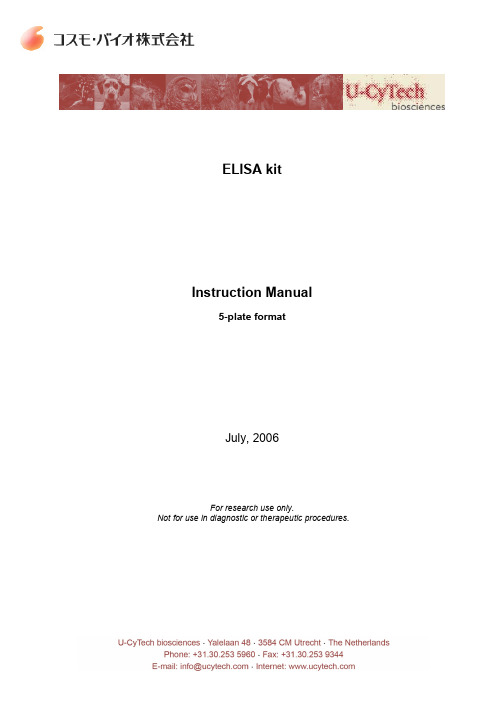
ELISA kitInstruction Manual5-plate formatJuly, 2006For research use only.Not for use in diagnostic or therapeutic procedures.ContentsAbbreviations 2 Introduction 3 Contents of the kit 4 Hazard information 4 Materials and reagents required but not provided 4 Working solutions 4 General procedure 5 Coating antibodies 5 Blocking 5 Test samples and standards 5 Biotinylated detector antibodies 5 SPP conjugate 5 Substrate 5 Cytokine standards 6 Storage kit reagents 6 Directions for washing 7 Trouble shooting 7 References 8AbbreviationsAPC Antigen presenting cellsBSA Bovine serum albuminCD Cluster of differentiationCSB Cytokine stabilization bufferDMSO Dimethyl sulfoxideELISA Enzyme linked immunosorbent assayGM-CSF Granulocyte-Macrophage Colony Stimulating Factor IFN InterferonIL InterleukinMHC Major histocompatibility complexOD Optical densityPB Phosphate bufferPBS Phosphate buffered salinePBST PBS containing 0.05% Tween-20PBST-B PBST containing 0.5% bovine serum albuminSPP Streptavidin-HRP polymerT h T helper subsetTMB TetramethylbenzidineTNF Tumor necrosis factorIntroductionCytokines are a group of regulatory proteins critically involved in many physiological processes such as immune recognition, cell differentiation and cell proliferation. They have been identified in many vertebrate species and are produced by a variety of different cell types. Cytokines are usually produced transiently and locally, acting in a paracrine or autocrine manner. They interact with high affinity cell surface receptors specific for each cytokine or cytokine group and are active at very low concentrations mostly in the picogram range.It is well known now that the type of an antigen-specific immune response largely depends on the selection or preferential activation of defined CD4+T cell subsets (i.e. T h1 and T h2). Activation of these subsets is characterized by the secretion of distinct patterns of cytokines. T h1, but not T h2 cells, primarily secrete IL-2 and IFN-γ while T h2, but not T h1 cells, produceIL-4, IL-5, IL-6, IL-10 and IL-13. Other cytokines, such as TNF-α and GM-CSF are produced by both T h subsets. In addition, the production of IL-12 and IL-10, produced by antigen presenting cells (APC) such as macrophages and dendritic cells, critically contributes to the preferential expansion of T h1- or T h2-type of cells. For instance, early production of IL-12 is considered essential for the development of T h1 cells. On the other hand, the absence or low concentrations of IL-12 and IFN-γ in the early phase of an immune response and concomitant production of IL-4 by cells of the mastcell/basophil lineage or T cells themselves is known to favor the development of T h2 cells. In addition to their regulatory effects on T h subset differentiation, the cytokines released by the two types of T h cells also produce distinct effector functions. For instance, IL-4 and IFN-γhave differential or antagonistic activities on immunoglobulin isotype selection or MHC class II expression. Therefore, the properties of an immune response can be best studied by determining the amounts of cytokines produced by the responding T cells and APC.Contents of the kitItemsQuantity(5-plate format)StorageconditionsCoating antibodies 1 vial 4ºC (39ºF)Cytokine standard 5 vials 4ºC (39ºF)Biotinylated detector antibodies 1 vial 4ºC (39ºF)SPP conjugate (Streptavidin-HRP polymer) 1 vial ≤ -20ºC (-4°F)TMB substrate tablets 5 4ºC (39ºF)Substrate buffer capsules 5 Rt*BSA stock solution (10%) 2 vials (24 ml) 4ºC (39ºF)Cytokine stabilization buffer (CSB)** 1 vial (5 ml) 4ºC (39ºF)Tween-20 1 vial (5 ml) Rt*ELISA plates8 Rt*Adhesive cover slips 10 Rt** Room temperature** For serum and plasma samples only; see under “Test samples and standards”Materials and reagents required but not provided•PB stock: dissolve 96.0 g Na2HPO4.2H2O plus 17.5 g KH2PO4in 1.0 L distilled water and adjust pH to 7.4•Sterile distilled water•H2SO4•Dimethyl sulfoxide (DMSO)•Pipetting devices for the accurate delivery of volume required for the assay performance •Plate washer: automated or manual (squirt bottle, manifold dispenser, etc)•Reading device for microtiter-plate set to 370, 450 and/or 655 nmWorking solutions•PBS: add 10 ml PB stock and 8.8 g NaCl to 1 L distilled water. Adjust pH to 7.4.Alternatively, use commercially available liquid PBS from Invitrogen or other suppliers.Do not use commercially available PBS tablets for the preparation of the coating solution (the filler in the tablets interferes with the coating process).•PBST: 0.5 ml Tween-20 dissolved in 1 L PBS.•PBST-B: 2 ml BSA stock solution (10%) added to 38 ml PBST.•Blocking buffer: 2 ml BSA stock solution (10%) added to 18 ml PBS (for 1 ELISA plate). •Substrate buffer: the contents of one capsule is dissolved in 100 ml distilled water (takes approximately 5 minutes). For optimal performance, the buffer solution should be used within60 minutes.•Stopping solution: 2 M H2SO4TMB (tetramethylbenzidine) and sodium perborate (in substrate buffer)General procedureCoating antibodies•Reconstitute the lyophilized antibodies by injecting 250 µl of sterile distilled water into the vial. Mix the solution gently for approximately 15 seconds and allow it to stand for 2 minutes at room temperature. Avoid vigorous shaking. To coat 96 wells of an ELISA plate 50 µl is pipetted out of the vial (or use a frozen aliquot of 50 µl; see "Storage kit reagents") and added to 5 ml PBS. Mix gently.•Add 50 µl of diluted antibody solution to each well of the ELISA plate and fill up to 100 µl with PBS.•Seal the plate to prevent evaporation.Incubate overnight at 4ºC or alternatively 1 to 2 hours at 37ºC.Blocking•Remove the coating antibody solution and wash the wells at least six times with PBST. •Add 200 µl of blocking buffer.•Seal the plate and incubate at 37ºC for 1 hour.Test samples and standards•Remove the blocking buffer but do not wash.•Add 1/20 volume of CSB to serum or plasma samples but not to other samples such as cell culture supernatants; CSB inhibits the degradation of cytokines in pure serum or plasma. •Dilute standards and test samples in an appropriate diluent (see “Cytokine standards”). •Add 100 µl to each well.•Seal the plate and incubate at 37ºC for 2 hours or overnight at 4ºC.Biotinylated detector antibodies•Remove test samples/standards and wash the wells at least six times with PBST. •Reconstitute the lyophilized antibodies by injecting 0.5 ml of sterile distilled water into the vial. Mix the solution gently for approximately 15 seconds and allow it to stand for 2 minutes at room temperature. Avoid vigorous shaking. Hundred microliter is pipetted out of the vial (or use a frozen aliquot of 100 µl; see "Storage kit reagents") and added to 10 ml PBST-B.Mix gently.•Add 100 µl of diluted antibody solution to each well.•Seal the plate and incubate at 37ºC for 1 hour.SPP conjugate•Remove detector antibody solution and wash the wells at least six times with PBST. •Reconstitute the contents of the vial by injecting 0.5 ml of sterile distilled water into the vial.Mix the solution gently for approximately 15 seconds and allow it to stand for 1 minute at room temperature. Avoid vigorous shaking. Hundred microliter is pipetted out of the vial (or use a frozen aliquot of 100 µl; see "Storage kit reagents") and added to 10 ml PBST-B. Mix gently.•Add 100 µl to each well.•Seal the plate and incubate at 37ºC for 1 hour.Substrate•Remove SPP conjugate and wash the wells at least six times with PBST.•Dissolve one TMB tablet in 1.0 ml DMSO (vortex at high speed for 5 minutes for complete dissolution)and than add 10 ml substrate buffer.•Mix thoroughly and immediately dispense 100 µl into each well. Leave the plate on the laboratory bench at room temperature (color development between 10 and 30 minutes).The substrate produces a soluble end-product that is blue in color and can be read spectrophotometrically at 370 or 655 nm. The reaction can be stopped by adding 50 µl of2 M H2SO4 (resulting in a yellow solution which can be read at 450 nm).Cytokine standardsFor maximum recovery, the vial with lyophilized cytokine standard should be reconstituted in 0.5 ml distilled water and allowed to stand for 1 minute at room temperature. Thereafter, the reconstituted cytokine standard (stock solution) is placed on melting ice and is immediately diluted as indicated below (preferentially within one hour). Use vials with cytokine standards only once.Please note that temperature of buffers and standard solution(s) should now be kept at 0-4ºC until use in the ELISA.The total amount of cytokine standard is indicated on the label of the vial (ng/vial). After reconstitution in 0.5 ml water, the concentration (ng/ml) will become twice the amount on the label [e.g. amount on label is 4.8 ng/vial; after reconstitution, the concentration becomes9.6 ng/ml = 9600 pg/ml].The standard stock solution is diluted to 320 pg/ml in PBST-B (highest concentration cytokine to be used in the standard range).The linear region of the cytokine standard curve is now obtainable in a series of two-fold dilutions in PBST-B ranging from 320 to 5 pg/ml. Always include a blank control (PBST-B only) in the standard range.Before establishing the standard curve, the OD value of the blank control (OD.bl) is subtracted from the measured OD values of the different standard solutions. The standard curve is now plotted as the standard cytokine concentration versus the corresponding (measured) OD value minus OD.bl. In addition, the actual OD values of the test samples are determined by subtracting OD.bl from the measured OD values.The concentration of the cytokine in the test sample can then be interpolated from the standard curve. It is useful to prepare a series of dilutions of the unknown test sample to assure that the OD will fall in the linear portion of the standard curve.Note 1: The OD value measured for the blank control (OD.bl) must be below 0.2.Note 2: for measuring cytokines in cell culture supernatant, samples should be diluted inPBST-B. However, when measuring cytokines in pure serum or plasma, the diluent for the standard and blank control should preferentially be control serum or plasma originating from the same species.Storage kit reagentsThe vials with lyophilized coating antibodies and biotinylated detector antibodies can be safely stored in a refrigerator for a defined length of time (expiry date indicated on the vial). After reconstitution, the antibodies remain fully active for minimal 6 months at 4ºC (39ºF) when kept sterile. However, it is strongly recommended to divide the reconstituted antibody solutions into small aliquots for single use. These aliquots should be stored at ≤-20ºC. Under these conditions the antibodies are stable for at least one year.Upon arrival, the vial with lyophilized SPP conjugate should be stored at ≤ -20°C. Storage of the vial at room temperature or at 4ºC for several months may lead to lower OD readings in the ELISA. After reconstitution, the SPP solution is stable for 2 months at 4°C but rapidly looses activity when stored at room temperature. It is strongly recommended that after reconstitution, the solution is immediately divided into small aliquots for single use and stored at ≤-20°C. Under these conditions SPP is stable for minimal 12 months.Directions for washing•Incomplete washing will adversely affect the assay. All washing must be performed with wash buffer (PBST).•Washing can be performed manually as follows: completely aspirate the liquid from all wells by gently lowering an aspiration tip (aspiration device) into each well. After aspiration, fill the wells with at least 300 µl wash buffer. Let soak for 10 to 20 seconds, then aspirate the liquid. Repeat as directed under "General procedure". After washing, the plate is inverted and tapped dry on absorbent paper.•Alternatively, the wash buffer may be put into a squirt bottle. If a squirt bottle is used, flood the plate with wash buffer, completely filling all wells. After washing, the plate is inverted and tapped dry on absorbent paper.•If using an automated washing device, the operating instructions should carefully be followed.Trouble shooting•Poor consistency of replicates can be overcome by increasing the stringency of washes particularly after the incubation step with detector antibody.•High values of the blank control (optical density > 0.2) can be overcome by shortening the incubation time with the substrate solution or is caused by improper washing procedures. •Inconsistent replicates may be due to cross-contamination of wells by improper pipetting procedures.•If no signal is observed in the wells with the standards•try a new vial with cytokine standard•check the pH of the substrate solution (between 5.0 and 5.5)•verify whether the antibody, SPP conjugate and standardpreparations were properly diluted•Avoid sodium azide in wash buffers and diluents, as this is an inhibitor of peroxidase activity.•Storage of reconstituted SPP at room temperature for several days can lead to a significant loss of SPP activity and consequently low OD readings.ReferencesBooks:•Practice and theory of enzyme immunoassays 1985In: Laboratory techniques in biochemistry and molecular biology, Vol.15 (eds R.H.Burdon and P.H. van Knippenberg)Science Publishers bv, Amsterdam, The Netherlands•ELISA and other Solid Phase Immunoassays.Theoretical and Practical Aspects 1988(eds D.M.Kemeny and S.J.Challacombe)John Wiley & Sons Ltd, Chichester, UK• A practical guide to ELISA 1991(ed D.M.Kemeny) Pergamon Press, Oxford, UKReview of U-CyTech ELISA references:Human cytokines:•Arend, S.M. et al. 2000 J. Infect. Diseases 181: 1850-1854 •Demirkiran, A. et al. 2006 Liver Transpl. 12: 277-284 •Hoogendoorn, M. et al. 2005 Clin. Cancer Res. 11: 5310-5318 •Tang, Y-M. et al. 2006 World J. Gastroenterol. 11: 4575-4578•de Waal, L. et al. 2004 J. Virol. 78: 1775-1781Monkey cytokines:•Fallon, P.G. et al. 2003 J. Infect. Dis. 187: 939-945•Hartman, G. et al. 2005 Vaccine 23: 3310-3317•Kornfeld, C. et al. 2005 J. Clin. Invest. 115: 1082-1091 •Mascarell, L. et al. 2006 Vaccine 24: 3490-3499•Polakos, N.K. et al. 2001 J. Immunol. 166: 3589-3598•de Swart, R.L. et al. 2002 J. Virol. 76: 11561-11569Mouse cytokines:•Eijkelkamp, N. et al. 2004 J. Neuroimmun. 150: 3-9•Kavelaars, A. et al. 2005 J. Neuroimmun. 161: 162-168•Vroon, A. et al. 2005 J. Immunol. 174: 4400-4406Rat cytokines:•Dieleman, J.M. et al. 2006 Life Sci. 79: 551-558•Pacheco-López, G. et al. 2005 J. Neurosci. 25: 2330-2337•Sajti, E. et al. 2004 Brain Behav. Immun. 18: 505-514•Teunis, M.A.T. et al. 2002 J. Neuroimmun. 13: 30-38。
- 1、下载文档前请自行甄别文档内容的完整性,平台不提供额外的编辑、内容补充、找答案等附加服务。
- 2、"仅部分预览"的文档,不可在线预览部分如存在完整性等问题,可反馈申请退款(可完整预览的文档不适用该条件!)。
- 3、如文档侵犯您的权益,请联系客服反馈,我们会尽快为您处理(人工客服工作时间:9:00-18:30)。
人血小板活化因子(PAF)分析检测ELISA试剂盒使用说明书
本试剂仅供研究使用
Purpose目的:本试剂盒用于测定小鼠血清,血浆及相关液体样本中转化生长因子(PAF)的含量。
实验原理:
本试剂盒应用双抗体夹心法测定标本中人血小板活化因子(PAF)水平。
用纯化的转化生长因子(PAF)抗体包被微孔板,制成固相抗体,往包被单抗的微孔中依次加入转化生长因子(PAF),再与HRP标记的羊抗鼠抗体结合,形成抗体-抗原-酶标抗体复合物,经过彻底洗涤后加底物TMB显色。
TMB在HRP酶的催化下转化成蓝色,并在酸的作用下转化成最终的黄色。
颜色的深浅和样品中的转化生长因子(PAF)呈正相关。
用酶标仪在450nm波长下测定吸光度(OD值),通过标准曲线计算样品中人血小板活化因子(PAF)浓度。
试剂盒内容及其配制:
试剂盒成份96孔配置48孔配置
96/48人份酶标板1块板
(96T)
半块板
(48T)
塑料膜板盖1块半块
标准品:100ng/ml 1瓶
(1.0ml)
1瓶
(0.5ml)
空白对照1瓶
(1.0ml)
1瓶
(0.5ml)
标准品稀释缓冲液1瓶
(8.0ml)
1瓶
(4.0ml)
生物素标记的抗OT抗体1瓶
(8.0ml)
1瓶
(4.0ml)
亲和链酶素-HRP 1瓶
(12ml)
1瓶(5ml)
洗涤缓冲液1瓶
(20ml)
1瓶(10ml)
底物A 1瓶
(6.0ml)
1瓶
(3.0ml)
底物B 1瓶
(6.0ml)
1瓶
(3.0ml)
终止液1瓶
(6.0ml)
1瓶
(3.0ml)
试剂盒组成:
试剂盒组成48孔配置96孔配置保存
说明书1份1份
封板膜2片(48)2片(96)
密封袋1个1个
酶标包被板1×48 1×96 2-8℃保存标准品:45μ
mol/L
0.5ml×1瓶0.5ml×1瓶2-8℃保存标准品稀释液 1.5ml×1瓶 1.5ml×1瓶2-8℃保存酶标试剂 3 ml×1瓶 6 ml×1瓶2-8℃保存样品稀释液 3 ml×1瓶 6 ml×1瓶2-8℃保存显色剂A液 3 ml×1瓶 6 ml×1瓶2-8℃保存显色剂B液 3 ml×1瓶 6 ml×1瓶2-8℃保存终止液3ml×1瓶6ml×1瓶2-8℃保存
浓缩洗涤液(20ml×20倍)×1
瓶
(20ml×30倍)
×1瓶
2-8℃保存
自备材料:
1. 蒸馏水。
2. 加样器:5ul、10ul 、50ul 、100ul 、200ul 、500ul、1000ul。
3. 振荡器及磁力搅拌器等。
样品收集、处理及保存方法:
1、血清……操作过程中避免任何细胞刺激。
使用不含热原和内毒素的试管。
收集血液后,1000×g离心10分钟将血清和红细胞迅速小心地分离。
2、血浆……EDTA、柠檬酸盐、肝素血浆可用于检测。
1000 ×g离心30分钟去除颗粒。
3、细胞上清液……1000 ×g离心10分钟去除颗粒和聚合物。
4、组织匀浆……将组织加入适量生理盐水捣碎。
1000 ×g离心10分钟,取上清液。
5、保存……如果样品不立即使用,应将其分成小部分-70℃保存,避免反复冷冻。
尽可能的不要使用溶血或高血脂血。
如果血清中大量颗粒,检测前先离心或过滤。
不要在37℃或更高的温度加热解冻。
应在室温下解冻并确保样品均匀地充分解冻。
人血小板活化因子ELISA试剂盒操作注意事项:
●试剂应按标签说明书储存,使用前恢复到室温。
稀稀过后的标准品应丢弃,不可保存。
●实验中不用的板条应立即放回包装袋中,密封保存,以免变质。
●不用的其它试剂应包装好或盖好。
不同批号的试剂不要混用。
保质前使用。
●使用一次性的吸头以免交叉污染,吸取终止液和底物A、B液时,避免使用带金属部分的加样器。
●使用干净的塑料容器配置洗涤液。
使用前充分混匀试剂盒里的各种成份及样品。
●底物A应挥发,避免长时间打开盖子。
底物B对光敏感,避免长时间暴露于光下。
避免用手接触,有毒。
实验完成后应立即读取OD值。
●加入试剂的顺序应一致,以保证所有反应板孔温育的时间一样。
●按照说明书中标明的时间、加液的量及顺序进行温育操作。
安全性:
1. 避免直接接触终止液和底物A、B,一旦接触到这些液体,请尽快用水冲洗。
2. 实难中不要吃喝、抽烟或使用化妆品。
3. 不要用嘴吸取试剂盒里的任何成份。
试剂的准备:
1. 标准品:标准品的系列稀释应在实验时准备,不能储存。
稀释前将标准品振荡混匀。
稀释比例按下表中进行:
100 ng/ml (6号标
准品)
原倍浓度不用稀释直
接加入50ul
50
ng/ml (5号标
准品)
100ul的原倍标准品
加入100ul的标准品
稀释液
25
ng/ml (4号标
准品)
100ul的5号标准品加
入100ul的标准品稀
释液
12.5 ng/ml (3号标
准品)
100ul的4号标准品加
入100ul的标准品稀
释液
6.25 ng/ml (2号标
准品)
100ul的3号标准品加
入100ul的标准品稀
释液
3.12 ng/ml (1号标
准品)
100ul的2号标准品加
入100ul的标准品稀
释液
ng/ml (空白对
照)
原倍浓度不用稀释直
接加入50ul
2. 洗涤缓冲液(50×)的稀释:蒸馏水50倍稀释。
试剂盒性能:
1. 灵敏度:最小的检测浓度小于1号标准品。
稀释度的线性。
样品线性回归与预期浓度相关系数R值为0.990。
2. 特异性:不与其它细胞因子反应。
3. 重复性:板内、板间变异系数均小于10%。
人血小板活化因子ELISA检测试剂盒操作步骤:
1. 使用前,将所有试剂充分混匀。
不要使液体产生大量的泡沫,以免加样时加入大量的气泡,产生加样上的误差。
2. 根据待测样品数量加上标准品的数量决定所需的板条数。
每个标准品和空白孔建议做复孔。
每个样品根据自己的数量来定,能使用复孔的尽量做复孔。
3. 加入稀释好后的标准品50ul 于反应孔、加入待测样品50 ul 于反应孔内。
立即加入50 ul的生物素标记的抗体。
盖上膜板,轻轻振荡混匀,37℃温育45分钟。
4. 甩去孔内液体,每孔加满洗涤液,振荡30秒,甩去洗涤液,用吸水纸拍干。
重复此操作4次。
如果用洗板机洗涤,洗涤次数增加一次。
5. 每孔加入100ul的亲和链酶素-HRP,轻轻振荡混匀,37℃温育30分钟。
6. 甩去孔内液体,每孔加满洗涤液,振荡30秒,甩去洗涤液,用吸水纸拍干。
重复此操作4次。
如果用洗板机洗涤,洗涤次数增加一次。
7. 每孔加入底物A、B各50ul,轻轻振荡混匀,37℃温育5分钟。
避免光照。
8. 取出酶标板,迅速加入50ul终止液,加入终止液后应立即测定结果。
9. 在450nm波长处测定各孔的OD值。
结果判断与分析:
1、仪器值:于波长450nm的酶标仪上读取各孔的OD值
2、以吸光度OD值为纵坐标(Y ),相应的OT 标准品浓度为横坐标(X ),做得相应的曲线,样品的OT 含量可根据其OD 值由标准曲线换算出相应的浓度,再乘以稀释倍数;或用标准物的浓度与OD值计算出标准曲线的回归方程式,将样品的OD值代入方程式,计算出样品浓度,再乘以稀释倍数,即为样品的实际浓度。
3、检测值范围: 0-100ng/ml
4、敏感度:0.39ng/ml。
